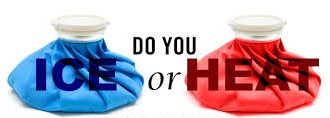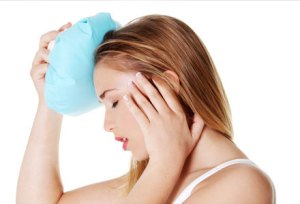 When do you use a hot or cold compress? In my profession I get asked this quite often. There are very distinct differences between hot and cold which make for better uses on different problems. So to begin with, narrow in on what you are feeling.
When do you use a hot or cold compress? In my profession I get asked this quite often. There are very distinct differences between hot and cold which make for better uses on different problems. So to begin with, narrow in on what you are feeling.
Is it a tension issue? Do you feel an ache or dull pain? Is there lack of blood flow or weakened muscles? These characteristics mean you would benefit from heat being applied. Heat vasodilates, or opens the vessels to allow for more blood flow. This will increase the detoxing of chemicals (i.e., lactic acid) that build up in your muscles that could be causing  the issue. There are several types of ways to deliver heat to an injured area, so here are a few to try at home.
the issue. There are several types of ways to deliver heat to an injured area, so here are a few to try at home.
- Take a kitchen towel and get it damp. Place in microwave for about a minute, no more. If too hot use another dry towel around it as a barrier between the skin. This will prevent any burning.
- A heating pad is a great way to add heat to a larger area that needs heating. Always use a pad that has a timer to prevent any electrical fires or burning from overuse.
- My favorite application of a heat is to soak in a warm bath. This is an all over heating that will encourage a full body detoxification. To further your experience add a bath salt of any kind. My personal favorite is epsom salt.
You only need to apply for 20 minutes because the body has done all it can with heat by then. Instances I use heat include cramping (menstruation), headaches, trigger points (also known as knots), and almost any eye issue.
Now if the pain in the body is sharp and is tender to touch or if you have swelling or inflammation in an area then you are going to benefit more from a cold compress. Cold closes the vessels reducing the amount of fluids being pumped into an area; a process known as vasoconstricting. Ice is also very beneficial for numbing an area of pain. Here are several types of cold compress you can do at home:
- Easy enough is to apply an ice pack from the freezer. If you don’t have one, frozen veggies work just as well. In case you have neither you can make one a few different ways.
- One way is to make a slushie pack by adding one half water and one half rubbing alcohol to a baggie. Seal the bag and place in freezer. The alcohol will keep the water from completely freezing and you will have a nice flexible ice pack to wrap around your injury any time.
- You can also make what we call boo-boo bags in preschool class. This is simply a paper towel or rag that is wet and set in a bag then frozen. We kept them on hand for any little scrape or bruise.
- Also simply add ice to a bag and apply to the area.
It is always best to have a barrier such as a towel to put between you and the cold compress. Cold is most effective up to 30 minutes, that is when your body has done all it can with the compress.
A method taught to me through my training as a massage therapist was called the “pump method” or contrast hot and cold hydrotherapy. This is where you use both applications one after the other to achieve a push-pull effect through the lymph system. It is best used on chronic injuries 21 days or older that need a much more efficient healing process.
When it comes to injuries always use your best judgment and consult a doctor if it is serious. Whether its to help a headache or relieve the aches a simple massage and compress can go a long way. Trust me I am a professional.
